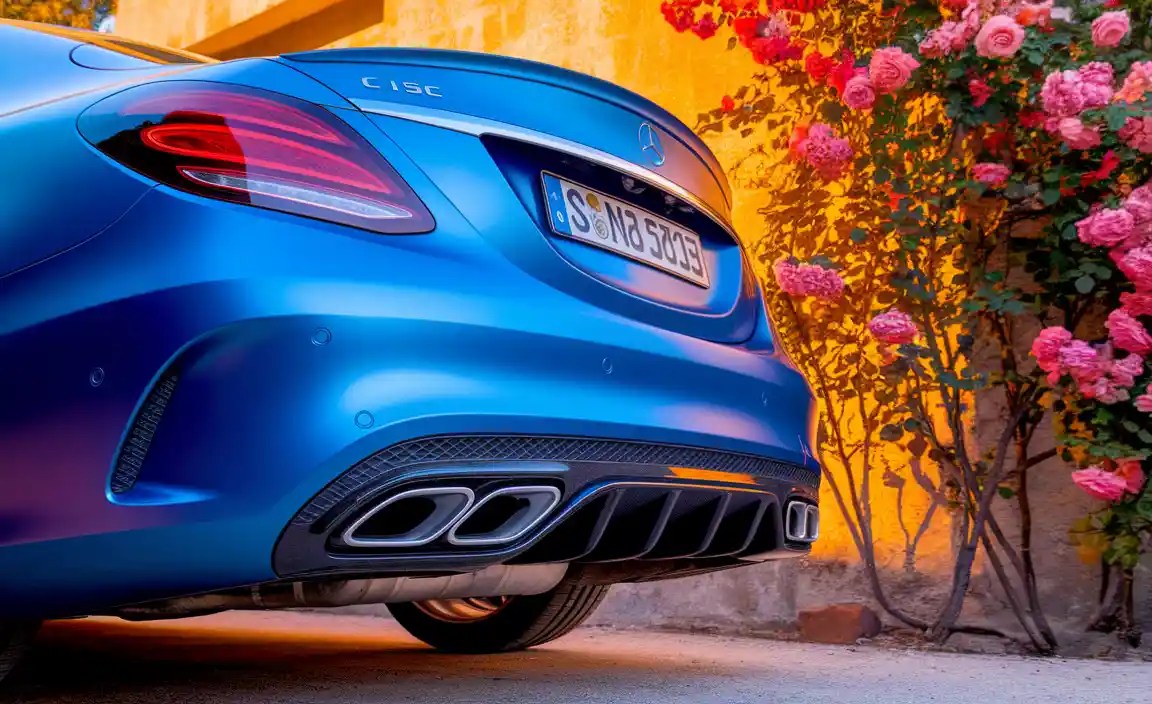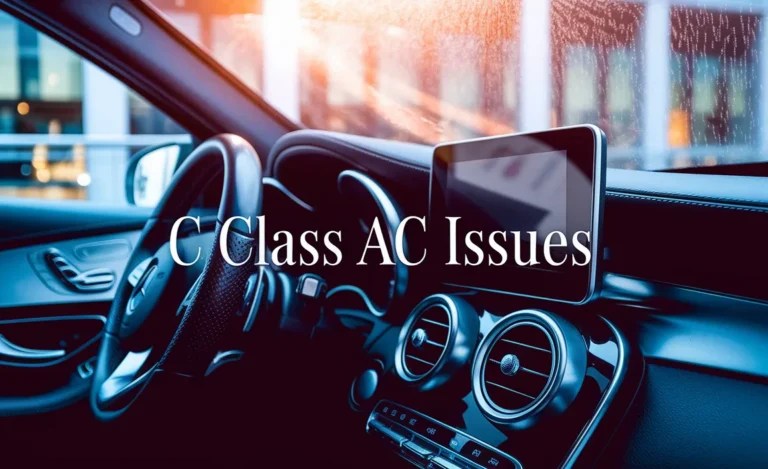Mercedes-Benz C Class Cat Back Exhaust: The Ultimate Upgrade
A C-Class cat-back exhaust upgrade can enhance your Mercedes-Benz’s sound and performance, offering a sportier driving experience and a more aggressive exhaust note. It’s a popular modification for those seeking to personalize their luxury sedan.
Have you ever felt your Mercedes-Benz C-Class is missing a little something? Perhaps it’s the engine’s voice, which, while refined, doesn’t always convey the performance lurking beneath the hood. Many C-Class owners find themselves drawn to the idea of upgrading their exhaust system, and a “cat-back” exhaust is often the first and most recommended step.
It’s a change that can transform the driving experience, adding a satisfying growl and a touch of sportiness without overwhelming the car’s luxurious character. If you’re curious about what a cat-back exhaust entails and whether it’s the right move for your C-Class, you’ve come to the right place. We’ll break down everything you need to know, making this upgrade accessible and exciting.

What Exactly is a C-Class Cat-Back Exhaust?
Before diving into the world of exhaust upgrades, let’s clarify what a “cat-back” exhaust system actually is. For your Mercedes-Benz C-Class, the factory exhaust system is designed for quiet, efficient operation, prioritizing comfort and emissions control. A cat-back exhaust system replaces everything from the catalytic converter(s) back to the tailpipes. This typically includes the mid-pipe (or pipes, depending on your C-Class model), the muffler(s), and the exhaust tips.

Think of it like this: the catalytic converter is a crucial component that reduces harmful emissions. A cat-back system leaves this vital part untouched, focusing solely on improving the sound and flow of exhaust gases after they’ve been processed. This makes it a popular and generally straightforward modification, often less complex and less likely to interfere with emissions regulations than exhaust manifolds or full turbo-back systems.
Why Upgrade Your C-Class Exhaust? Key Benefits
The allure of a C-Class cat-back exhaust upgrade extends beyond just aesthetics. While the visual appeal of new exhaust tips is undeniable, the primary drivers for this modification are usually:
- Enhanced Sound: This is often the number one reason. A well-designed cat-back exhaust can transform your C-Class’s soundtrack from a muted hum to a more engaging, sporty, and sometimes aggressive tone. It allows you to hear more of the engine’s character, especially during acceleration, without being intrusive during normal driving.
- Improved Performance: By reducing restrictions in the exhaust pathway after the catalytic converter, a cat-back system can allow the engine to breathe more freely. This can lead to a slight increase in horsepower and torque. While not as dramatic as a full engine tune or turbo upgrade, it’s a tangible improvement that complements the car’s inherent performance.
- Weight Reduction: Aftermarket exhaust systems are often constructed from lighter materials, such as stainless steel or even titanium, compared to the heavier, stock components. This reduction in weight, though often minor, contributes to overall vehicle performance and handling.
- Customization & Aesthetics: Manufacturers offer a wide variety of exhaust tip designs and finishes. This allows you to personalize the rear of your C-Class to match its style, whether you prefer a subtle, integrated look or a more prominent, sporty appearance.
- Driving Engagement: A more responsive exhaust note can significantly increase the driver’s connection to the car. It makes the act of driving more visceral and enjoyable, turning even mundane commutes into more engaging experiences.
Understanding C-Class Exhaust Sound Profiles
One of the most exciting aspects of a cat-back upgrade is the sound. Mercedes-Benz is known for its refined luxury, and the stock exhaust reflects this. However, aftermarket C-Class cat-back exhausts offer a spectrum of sound:

- Subtle & Refined: For those who want a touch more character without attracting undue attention, systems designed to offer a deeper, sportier tone at the upper limits of the RPM range, while remaining relatively quiet at idle and cruising speeds.
- Sporty & Aggressive: These systems provide a noticeable growl under acceleration and a more pronounced, satisfying note when driven hard. They strike a balance between performance and daily drivability.
- Race-inspired (Less Common for C-Class): While less common for standard C-Class models (but more so for AMG variants), some systems can offer a much more aggressive, loud exhaust note, often with significant drone at certain RPMs. This is usually for enthusiasts who prioritize sound above all else.
It’s important to research specific brands and models to find a sound profile that matches your personal preference. Many manufacturers provide video and audio samples of their systems installed on similar C-Class models.
Types of C-Class Cat-Back Exhaust Systems
When looking for a C-Class cat-back exhaust, you’ll encounter a few key design variations that influence sound, performance, and cost:
Muffler Design and Its Impact
The muffler is the heart of the exhaust system’s sound-dampening capability. Different designs affect the tone and volume:
| Muffler Type | Description | Typical Sound Profile | Performance Impact |
|---|---|---|---|
| Resonator-Type (Chambered) | Uses internal chambers to cancel out specific sound frequencies, particularly droning. | Deeper, more mellow tone, often with less drone. Good for daily drivers. | Moderate improvement due to flow management within baffling. |
| Straight-Through (Perforated Core) | Features a perforated inner pipe surrounded by sound-absorbing packing material. | Louder, more aggressive, sportier tone. Can sometimes introduce more drone. | Best potential for improved flow and performance due to less restriction. |
| Muffler Delete/Muffler Bypass | Removes the muffler entirely, often replaced with a straight pipe. | Loudest, most aggressive sound. High potential for drone and may not be legal in all areas. | Maximum potential for improved flow, but sound can be overwhelming. |
Material Considerations
The material used impacts durability, weight, and corrosion resistance:
- 304 Stainless Steel: This is the gold standard for aftermarket exhausts. It offers excellent corrosion resistance, strength, and a premium look. It’s more expensive but provides the best long-term value.
- 316 Stainless Steel: Similar to 304 but with added molybdenum, offering even greater corrosion resistance, especially in harsh environments.
- Mild Steel (often coated): Less expensive but more prone to rust and corrosion over time, especially in regions with salt on the roads. Often coated to prolong life.
Single vs. Dual-Tip Configurations
While not strictly a “type” of system regarding sound or performance, the number and style of exhaust tips are a significant aesthetic choice. Most C-Class models come with dual exhaust outlets from the factory, and cat-back systems often replicate or enhance this, offering various tip styles (e.g., polished, carbon fiber, black chrome) and diameters.
The Installation Process: A DIY Guide for Your C-Class
Installing a cat-back exhaust on a Mercedes-Benz C-Class can be a rewarding DIY project for those with basic mechanical knowledge and the right tools. However, it’s crucial to assess your comfort level and resources. If you’re unsure, professional installation is always recommended.

Tools and Materials You’ll Need
Gathering the right equipment beforehand will make the process smoother and safer:
- New C-Class Cat-Back Exhaust System
- Socket Wrench Set (Metric)
- Torque Wrench
- Jack and Jack Stands (ensure they are rated for your vehicle’s weight)
- Wheel Chocks
- Penetrating Oil (e.g., PB Blaster)
- Wire Brush
- Rubber Mallet
- Safety Glasses
- Work Gloves
- New Exhaust Gaskets and Hardware (often included with the exhaust kit, but good to have extras)
- (Optional) Exhaust Hanger Removal Pliers
- (Optional) Metal File or Grinder for cleaning pipe ends
Step-by-Step Installation Guide
- Prepare the Vehicle: Park your C-Class on a level surface. Engage the parking brake and place wheel chocks behind the rear wheels for extra safety.
- Lift and Secure the Vehicle: Using a reliable jack, lift the rear of the vehicle high enough to comfortably work underneath. Place sturdy jack stands under the designated frame points. Always double-check the stability of the vehicle before proceeding. Never rely solely on a jack.
- Locate and Inspect the Stock Exhaust: Familiarize yourself with the existing exhaust system, noting where it’s clamped or bolted. Identify the hangers supporting the pipes.
- Soften Up Stubborn Bolts: Spray penetrating oil on all bolts and nuts connecting the stock exhaust sections from the muffler back. Let it sit for at least 15-20 minutes. This is crucial for easier removal.
- Remove the Stock Exhaust:
- Use a wire brush to clean rust and debris from the clamp or bolt areas.
- Loosen and remove the clamps or bolts connecting the muffler section to the rest of the exhaust.
- Carefully detach the exhaust hangers from the rubber isolators. A rubber mallet might be needed to gently separate them. If the rubber is stuck, exhaust hanger removal pliers can be useful.
- On some models, you might need to detach the system from the mid-pipe before the catalytic converter.
- Gently work the old exhaust system out from under the car. It might be in one piece or require some maneuvering.
- Prepare for the New System: Clean the mating surfaces of the new exhaust pipes and where they will connect to the existing system (if not a full replacement from the cat-back). Ensure old gasket material or rust is removed.
- Install the New Cat-Back System:
- Begin installing the new exhaust components, typically starting from the mid-pipe back towards the tips.
- Loosely hang the new sections using the new hangers provided with the kit. Do not tighten any clamps or bolts yet.
- Ensure everything is aligned correctly and that there’s adequate clearance around suspension components, the drivetrain, and the bodywork.
- Tighten Everything Down: Once you confirm proper alignment and fitment, gradually tighten all clamps and bolts. Refer to the new exhaust system’s instructions for specific torque specifications. Overtightening can damage the pipes, while undertightening can lead to leaks and rattles.
- Double-Check All Connections: Ensure all clamps are secure, bolts are torqued correctly, and hangers are properly seated.
- Lower the Vehicle: Carefully lower the C-Class back to the ground.
- Start and Test: Start the engine and listen for any exhaust leaks (a hissing sound). Check for excessive vibration or rattling. Rev the engine gently to hear the new exhaust note.
- Final Checks: After a short test drive (around town), re-check all connections as the exhaust system can expand with heat, sometimes revealing leaks or loosening hardware.
Important Considerations for DIY Installers
Safety First: Always use jack stands and ensure the vehicle is stable. Never get under a car supported only by a jack. Wear safety glasses and gloves.
Rust is the Enemy: Older vehicles, especially those in humid or salty climates, can have seized bolts and rusted hangers. Be prepared for potential difficulties and have extra penetrating oil on hand. Sometimes, old hangers need to be cut off and replaced.
Alignment is Key: Improper alignment can cause the exhaust to rub against the chassis, suspension, or other components, leading to noise and potential damage. Take your time to get it right.
Leak Detection: After installation, a common issue is exhaust leaks at the connection points. A small amount of soapy water sprayed on the connections while the engine is running can reveal leaks by showing bubbles.
Emissions Compliance: This guide focuses on cat-back systems, which generally do not affect emissions. However, always ensure your chosen exhaust complies with local regulations regarding noise and emissions.
Choosing the Right C-Class Cat-Back Exhaust for Your Model
Mercedes-Benz offers the C-Class in various trims and engine configurations, from the more sedate C300 to the performance-oriented AMG C43 and C63 variants. The exhaust system design can differ significantly between these models, impacting which cat-back systems are compatible.

Compatibility is Crucial
- Engine Size: A C300 will have a different exhaust path and potentially fewer catalytic converters than a C63 AMG. Always select a cat-back system explicitly designed for your specific C-Class model year and engine (e.g., W205 C300, W206 C43).
- Drivetrain: Rear-wheel-drive (RWD) and All-wheel-drive (4MATIC) models can sometimes have slight variations in their exhaust routing due to the front driveshaft.
- Body Style: Sedan, Coupe, or Cabriolet versions of the same generation C-Class might have different lengths or routing requirements.
Information on compatibility is readily available on manufacturer and retailer websites. Look for detailed product descriptions that not only list compatible C-Class generations (e.g., W205, W206) but also specific engine codes or trim levels.
Top Brands in the C-Class Exhaust Market
Several reputable manufacturers specialize in high-quality exhaust systems for Mercedes-Benz vehicles. Each offers a unique blend of sound, performance, and build quality. Some popular choices include:
- Remus Exhausts: Known for their European flair and precise engineering, often providing a refined sporty tone.
- Akrapovič: A premium brand often associated with exotic materials like titanium, offering significant weight savings and a distinct, exhilarating sound.
- Meisterschaft: Offers a range of sound options, from mild to very aggressive, with impressive build quality.
- Borla: A well-known American manufacturer offering durable stainless steel systems with consistent sound profiles.
- Eisenmann: Highly regarded for their performance-oriented systems with a focus on deep, resonant sounds, especially for AMG models.
- FI Exhaust (Freedom of Choice Exhaust): Known for their electronic valve control systems that allow you to switch between different sound modes.
When researching brands, look for reviews and sound clips specific to your C-Class model. What sounds good on an AMG might be too aggressive for a C300, and vice-versa.
Performance and Sound Expectations
It’s important to manage expectations. A cat-back exhaust is primarily a sound and aesthetic upgrade. While you may feel a slight improvement in throttle response and a modest gain in horsepower (typically 5-15 hp, depending on the system and your C-Class’s engine), don’t expect dramatic power increases without further modifications like ECU tuning.
The sound is subjective. What one person finds thrilling, another might find annoying, especially if there’s significant drone (a resonant humming sound that occurs at a specific RPM, usually on the highway). Look for systems advertised as having “drone cancellation” or “resonators” if you prioritize a comfortable daily driving experience.
Common Issues and Troubleshooting Your New Exhaust
Even with a quality exhaust and careful installation, occasional issues might arise. Here’s how to address them:
Exhaust Leaks
Symptoms: A hissing or ticking sound from the exhaust, especially when the engine is cold. Often more noticeable at idle or during initial acceleration. Can also lead to a loss of performance.






